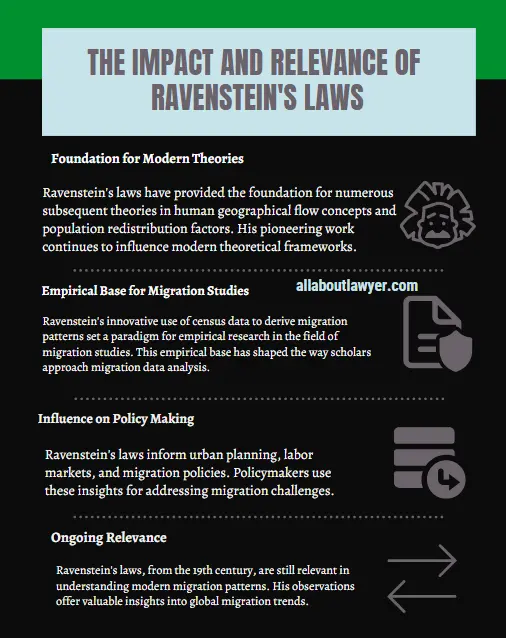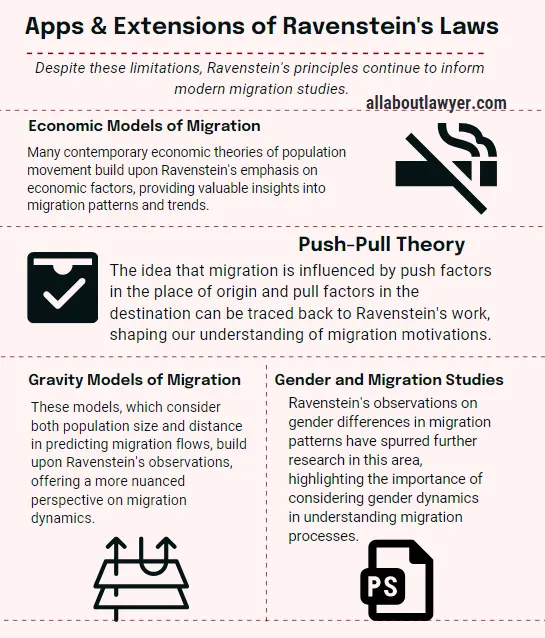How Many of Ravenstein’s Laws of Migration Exist? Evolution of His Theories
avenstein’s insights were groundbreaking: he identified several key factors that drive why, how, and where people move. His observations gave birth to what we now call the Laws of Migration, a set of principles that have shaped the study of human movement for over a century. Yet, a question persists among scholars and enthusiasts alike: How many migration laws did Ravenstein actually propose?
This article will not only answer that question but also explore the evolution of Ravenstein’s ideas and their profound impact on the field of population studies. Today, in a world where nearly 1 in 8 people—or around 1 billion individuals—are considered international migrants or internal movers, Ravenstein’s principles remain as relevant as ever, helping us decode the reasons behind demographic shifts and global migration trends.
Table of Contents
The Origins of Ravenstein’s Laws
Before we dive into the number of laws, it’s crucial to understand the context in which Ravenstein developed his theories. In the late 19th century, as a German-English geographer, Ravenstein embarked on a groundbreaking study of census data from England and Wales. His work aimed to identify patterns in human geographical transition and population displacement, laying the foundation for modern migration studies.
The Evolution of Ravenstein’s Laws
Ravenstein’s work on migration was not a single, definitive publication but rather a series of papers and presentations over several years. This evolutionary process has led to some confusion about the exact number of laws he proposed. Let’s explore this progression:
1. The Initial Presentation (1876)
In his first presentation to the Royal Statistical Society, Ravenstein introduced several observations about migration patterns, which would later form the basis of his laws.
2. The 1885 Paper
Ravenstein’s seminal paper, “The Laws of Migration,” published in the Journal of the Statistical Society, is often cited as the primary source of his laws. In this work, he outlined seven main laws of migration.
3. The 1889 Follow-up
Ravenstein presented a follow-up paper that expanded on his original work, incorporating data from Europe and North America. This presentation added new insights and refined his earlier principles.
The Core Laws of Migration
While the total count of Ravenstein’s laws can vary depending on how they are categorized and interpreted, most scholars agree on a core set of principles. Here are the seven fundamental laws often attributed to Ravenstein:
1. The Law of Short Distances
Most migrants only travel short distances, preferring to settle in nearby areas rather than distant lands.
2. The Law of Step Migration
Migration often occurs in stages, with people moving from rural areas to small towns, then to larger cities, and potentially to other countries.
3. The Law of Stream and Counterstream
For every major migration stream, there is a counterstream of people moving in the opposite direction, albeit usually smaller in volume.
4. The Law of Urban Attraction
Urban areas tend to attract more migrants than rural areas due to economic opportunities and social amenities.
5. The Law of Gender Differences
Ravenstein observed that women were more likely to engage in short-distance migration, while men were more prone to long-distance moves.
6. The Law of Technology and Migration
Improvements in transportation and communication technologies facilitate increased migration.
7. The Law of Economic Motivation
The majority of migration is driven by economic factors, with people moving to areas with better job prospects and higher wages.
Additional Principles and Variations
Beyond these seven core laws, Ravenstein proposed several other observations and principles that are sometimes included in the count of his laws:
8. The Dominance of Natives in Internal Migration
Ravenstein noted that the majority of migrants within a country were native to that country.
9. The Rural-Urban Migration Preference
He observed a general trend of people moving from rural to urban areas.
10. The Inverse Relationship Between Migration and Distance
As the distance increases, the number of migrants tends to decrease.
11. The Effect of Age on Migration
Young adults are more likely to migrate than other age groups.
The Debate on the Number of Laws
The question of how many laws Ravenstein actually proposed is subject to ongoing debate among scholars. Some sources cite as few as five laws, while others list up to eleven or twelve. This variation can be attributed to several factors:
1. Interpretation of Ravenstein’s Work
Different scholars have interpreted and categorized Ravenstein’s observations in various ways.
2. Combination of Similar Principles
Some researchers combine closely related principles into a single law, while others treat them separately.
3. Inclusion of Later Observations
Some counts include principles that Ravenstein developed in his later work or that were derived from his original observations by other scholars.
4. Focus on Core vs. Extended Principles
While some sources focus only on the most fundamental laws, others include a broader range of Ravenstein’s observations.
The Impact and Relevance of Ravenstein’s Laws
Regardless of the exact count, Ravenstein’s laws have had a profound and lasting impact on the field of migration studies:
1. Foundation for Modern Theories
Ravenstein’s work laid the groundwork for numerous subsequent theories in human geographical flow concepts and population redistribution factors.
2. Empirical Base for Migration Studies
His use of census data to derive migration patterns set a precedent for empirical research in the field.
3. Influence on Policy Making
Understanding these laws has helped inform policies related to urban planning, labor markets, and international migration.
4. Ongoing Relevance
Despite being formulated in the 19th century, many of Ravenstein’s observations remain relevant in understanding contemporary migration patterns.

Critiques and Limitations Of Ravenstein’s Laws
While Ravenstein’s laws continue to be influential, they have also faced criticism and limitations:
1. Historical Context
The laws were based on 19th-century data, primarily from England and Wales, which may limit their applicability to different cultural and historical contexts.
2. Oversimplification
Some critics argue that the laws oversimplify the complex decision-making processes involved in migration.
3. Technological Changes
Modern transportation and communication technologies have altered migration patterns in ways Ravenstein could not have foreseen.
4. Globalization
The increasing interconnectedness of the global economy has created new patterns of migration that may not fully align with Ravenstein’s observations.
Contemporary Applications and Extensions Of Ravenstein’s Laws
Despite these limitations, Ravenstein’s principles continue to inform modern migration studies:
1. Economic Models of Migration
Many contemporary economic theories of population movement build upon Ravenstein’s emphasis on economic factors.
2. Push-Pull Theory
The idea that migration is influenced by push factors in the place of origin and pull factors in the destination can be traced back to Ravenstein’s work.
3. Gravity Models of Migration
These models, which consider both population size and distance in predicting migration flows, build upon Ravenstein’s observations.
4. Gender and Migration Studies
Ravenstein’s observations on gender differences in migration patterns have spurred further research in this area.

Conclusion
The question of how many laws of migration Ravenstein proposed does not have a simple answer. While the core set of laws is often cited as seven, the total count can range from five to twelve or more, depending on interpretation and inclusion criteria. What remains clear, however, is the enduring impact of Ravenstein’s work on our understanding of human movement patterns.
Ravenstein’s laws, regardless of their exact number, continue to provide a valuable framework for understanding the complex phenomenon of migration. They serve as a testament to the power of empirical observation and the enduring relevance of foundational theories in the social sciences. As we face new challenges in the 21st century, from climate-induced migration to global economic shifts, Ravenstein’s work remains a crucial starting point for understanding and addressing the ever-evolving patterns of human mobility.
Related Articles For You:
What Are Ravenstein’s 5 Laws of Migration?
How Much Does a Lawyer Charge for U.S. Citizenship Application?
FAQs
Why is there confusion about the number of Ravenstein’s laws of migration?
The confusion arises from Ravenstein’s work being published over time, with different interpretations and categorizations by scholars. Some sources focus on core principles, while others include additional observations.
Are Ravenstein’s laws still relevant in the 21st century?
A: Yes, many of Ravenstein’s observations remain relevant, although they need to be adapted to account for technological advancements and globalization. They continue to provide a foundation for understanding migration patterns.
Did Ravenstein himself specify a certain number of laws?
Ravenstein did not explicitly number his laws. The categorization and numbering have been done by subsequent scholars interpreting his work.
How do Ravenstein’s laws apply to international migration?
While Ravenstein’s original work focused on internal migration, many of his principles can be applied to understand international migration patterns, especially regarding economic motivations and the impact of distance.
Can Ravenstein’s laws explain all types of migration?
While Ravenstein’s laws provide valuable insights, they don’t explain all types of migration, especially forced migration due to conflicts or natural disasters. Modern migration theories build upon Ravenstein’s work to address these complexities.
About the Author

Sarah Klein, JD, is a legal writer with experience in immigration and migration law, covering topics like green cards, marriage-based visas, and asylum applications. Through All About Lawyer, she provides straightforward legal insights to help individuals and families navigate complex immigration processes with clarity and confidence.
Read more about Sarah
